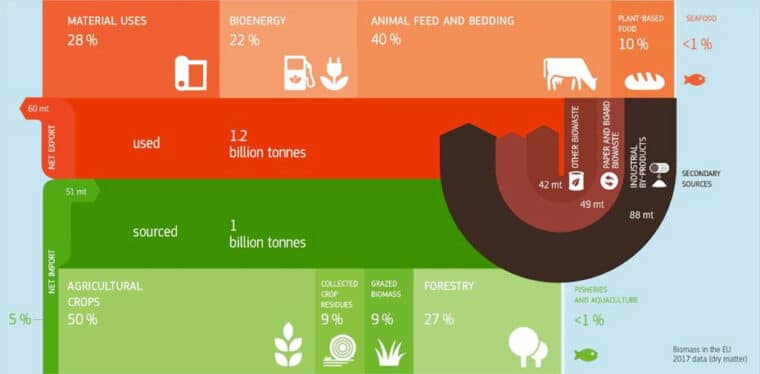The Joint Research Centre (JRC) of the European Commission have recently published a report on Biomass production, supply, uses and flows in the European Union.
The comprehensive and wide-ranging report provides an overview of biomass production and utilisation in the EU, including production, supply, uses and flows by sector, their impacts, and also highlights some more novel sources, and uses, of biomass. Much of this is summarised in a useful infographic within the report

Biomass Supply and Uses Inforgraphic from the JRC Science for Policy Report.
The European bioeconomy has grown significantly between 2010 and 2020, but so too has its environmental impact. The report acknowledges that demand for biomass is expected to increase and that direct and indirect impacts will occur as a result. For this reason, close monitoring of the impacts of increased biomass production is recommended. Imports to the EU-27 have been acknowledged as contributing to tropical deforestation. In response, in December 2022 the EU has agreed a law, yet to come into force, that is aimed at preventing global deforestation and creation of deforestation-free supply chains.
The report includes food production along with other forms of biomass production in effort to provide a better overview of the whole production system. Reporting on this basis, food production accounts for half of all biomass used in the EU. On a dry matter basis: 40% was used for animal feed and bedding, 9.7% plant-based food production, 28% in materials production and 22% for energy.
A brief summary of key points by biomass sector:
Forest and forest products
- EU Forests in 2020 were estimated to equate to 18.4 billion tonnes of dry matter over an area of 157 million hectares (ha).
- The forest biomass stock has increased by approximately 6 billion tonnes from 1990 – 2020 but the rate of growth is slowing down.
- Forest cover was at its most dense in central Europe and decreases toward northern and southern Europe.
- Forests were composed of roughly half broadleaved, half conifer woodland.
- Based on 2017 data, the total woody biomass used for material and energy in the EU-27 equated to 947 million cubic metres 45% of which was used for energy. Of the 424 m3 used for energy, 44% was from virgin timber, 48% from industrial residues and bark.
Agriculture
- The total annual agricultural biomass production across the EU-27 between 2016-2020 was estimated to be 924 million tonnes, 46 % of which were residues.
- Cereal straws constituted the greatest share of agricultural residues, producing on average 311 M t per year, with straws yielding 24% more dry matter than the economically harvested grain.
- Cereal straw residues were followed by residues from oil-bearing crops (72 M t per year), permanent crops (Olive and vineyard residues – 23 M t per year) and sugar/starch crops (12 M t per year). Energy crops averaged 0.15 M t per year.
Aquaculture
- The growing role of Macroalgae (seaweed) was emphasised as increasing in importance as a source of biomass.
- Its capacity to mitigate both direct and indirect climate change was emphasised owing to its carbon sequestration potential alongside its value as a resource in the food and chemical industry.
- In 2020, across the member states in 2020 0.17 M t were imported and 0.98 M t exported. The bulk of the trade occurred in Ireland and France.
Biorefining
- Around 2,362 biomass processing facilities are in operation across the EU, which include: pulp and paper (21.4%), bio-based chemicals (19.9%), timber (18.5%), biomethane (14.3%), liquid biofuels (12.8%), starch and sugar (7.6%) and composites and fibres (5.5%).
- Agricultural crops and residues are currently the main biomass used for chemical and material driven biorefineries, but those fed by woody or lignocellulosic biomass are estimated to have the highest growth potential.
- The bio-based share is estimated to be only 3% of the EU’s chemical market.
Biobased products
- There has been significant growth in innovative biobased products sectors such as cross-laminated timber (1.3 M m3 per yr), man-made cellulosic fibres (lyocell), bioplastics (0.5 M m3 per yr) and biocomposites (0.47 M m3 per yr). Many of which can replace fossil-based materials.
- Across Europe there are only 30 major wood-based composite producers, but in 2018 their combined production equated to nearly 470 thousand tonnes of bio-based composite products.
For more information the complete report can be found here.
Author: Dr. Edward Hodgson.



